
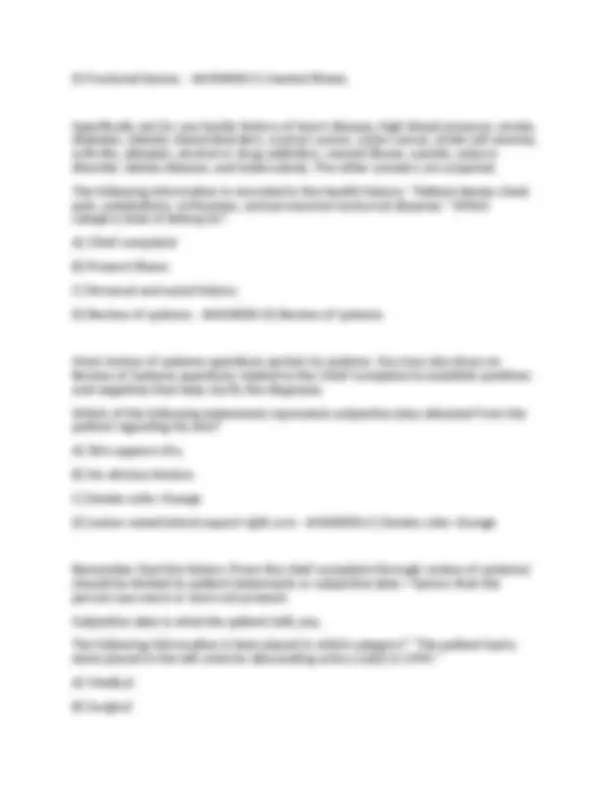
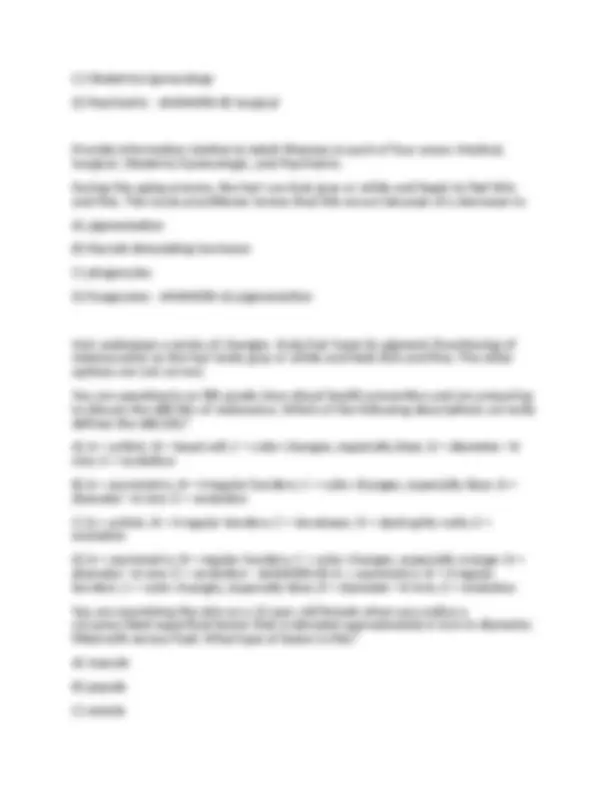

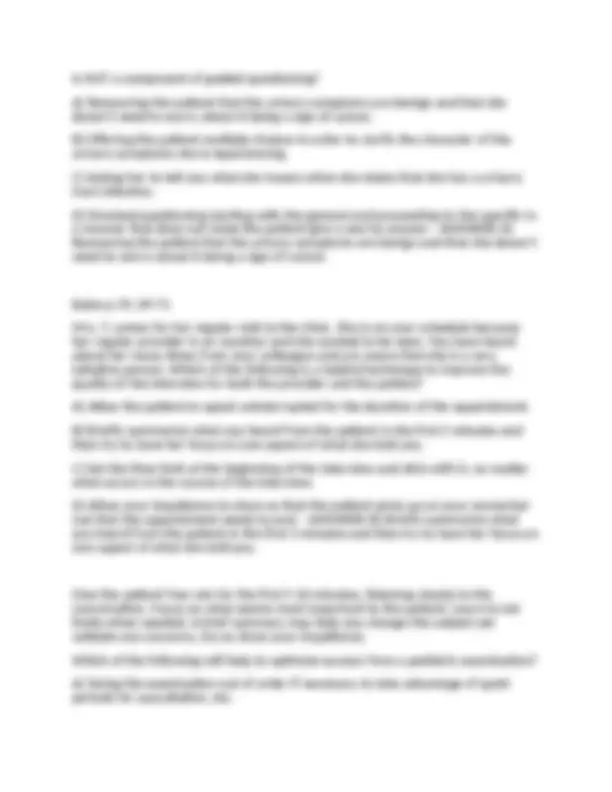
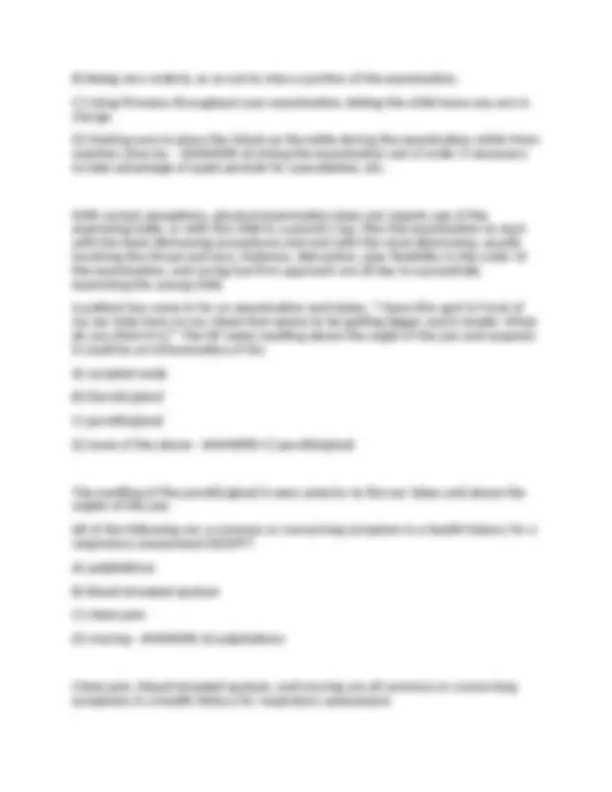

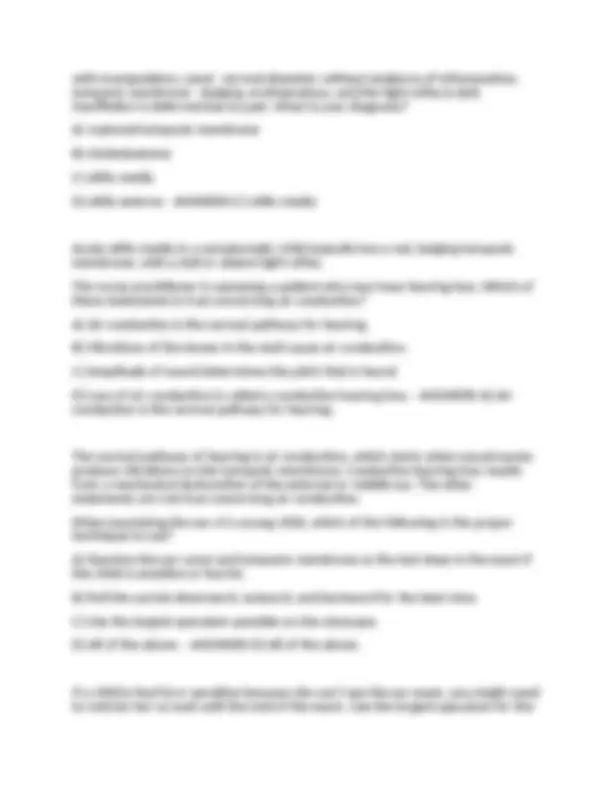
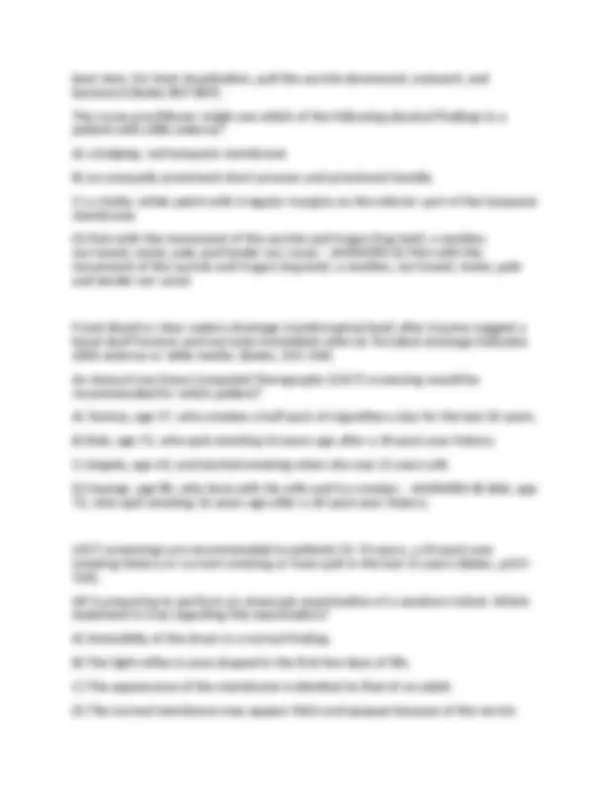
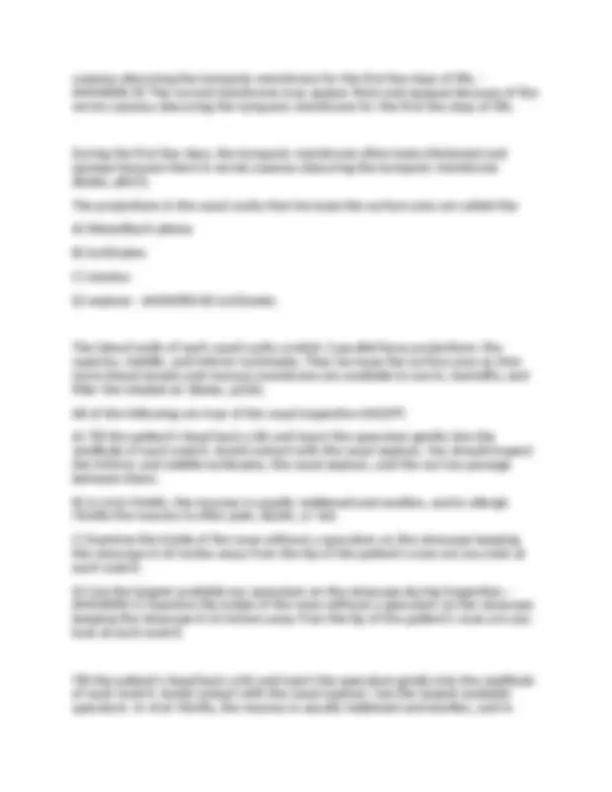
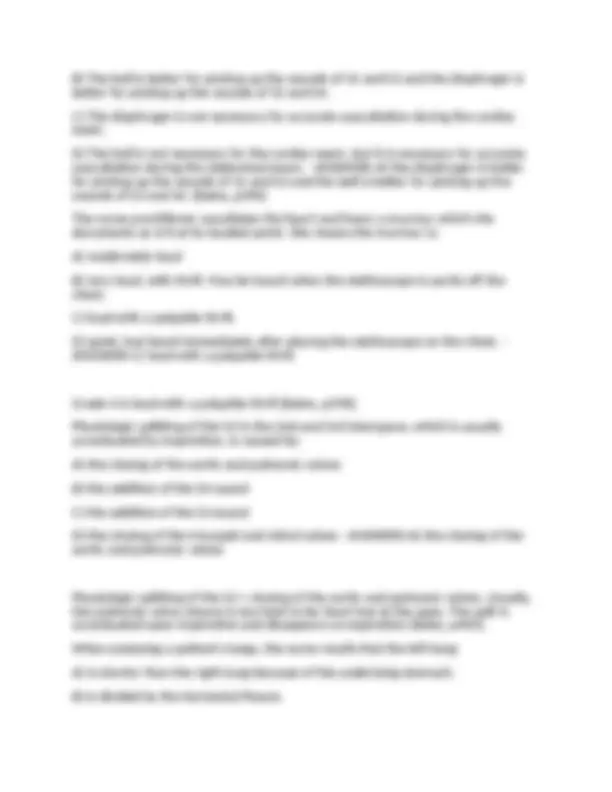
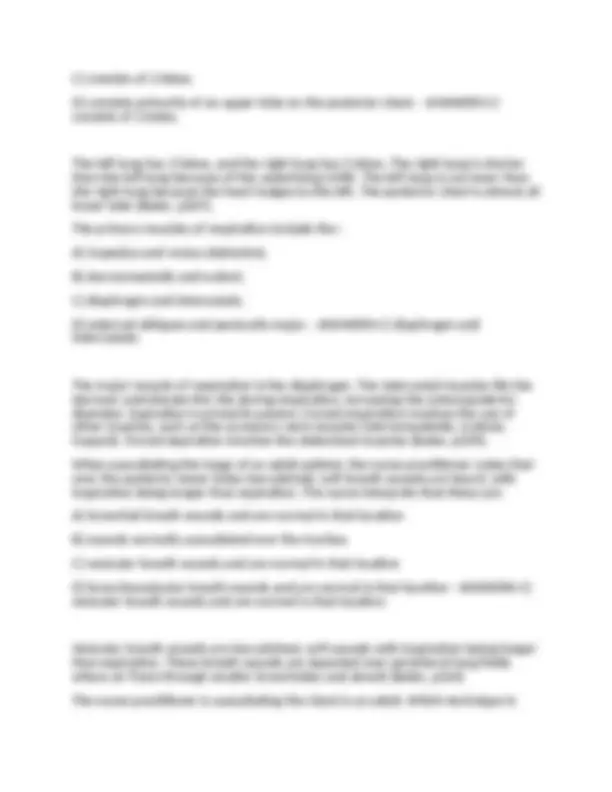
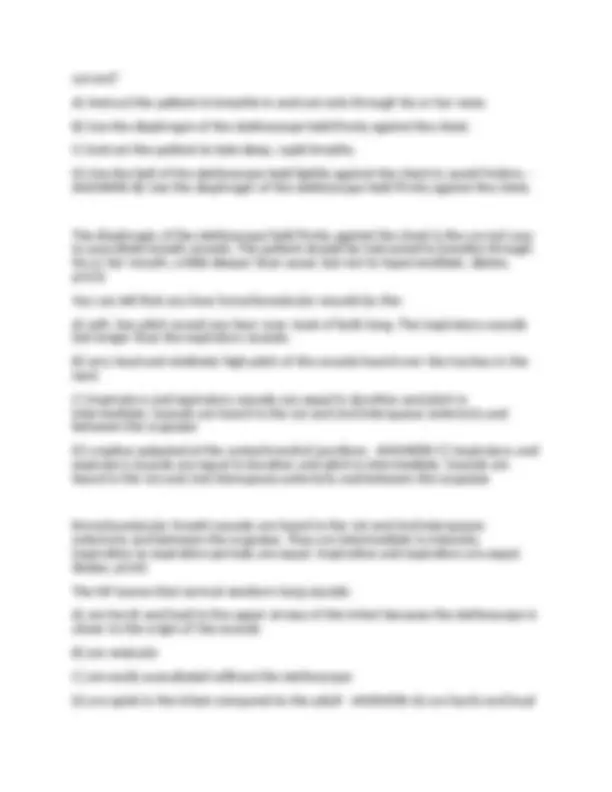
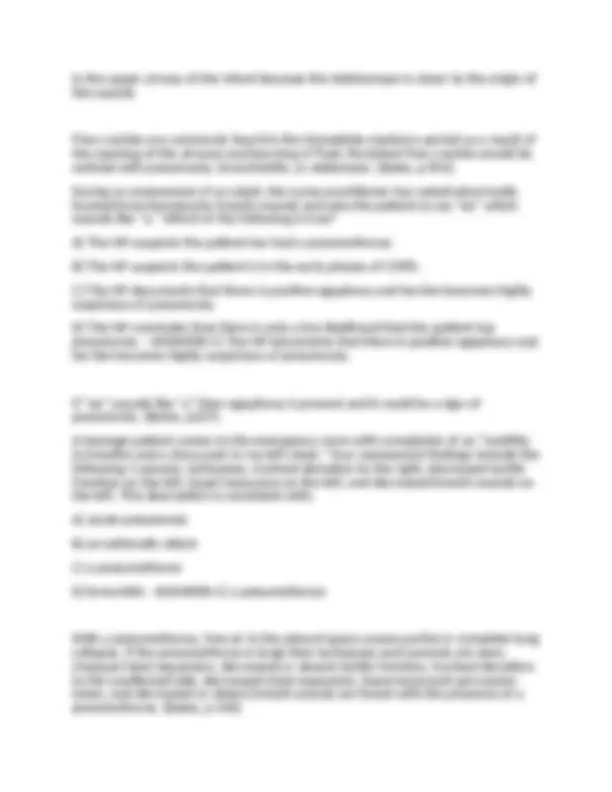
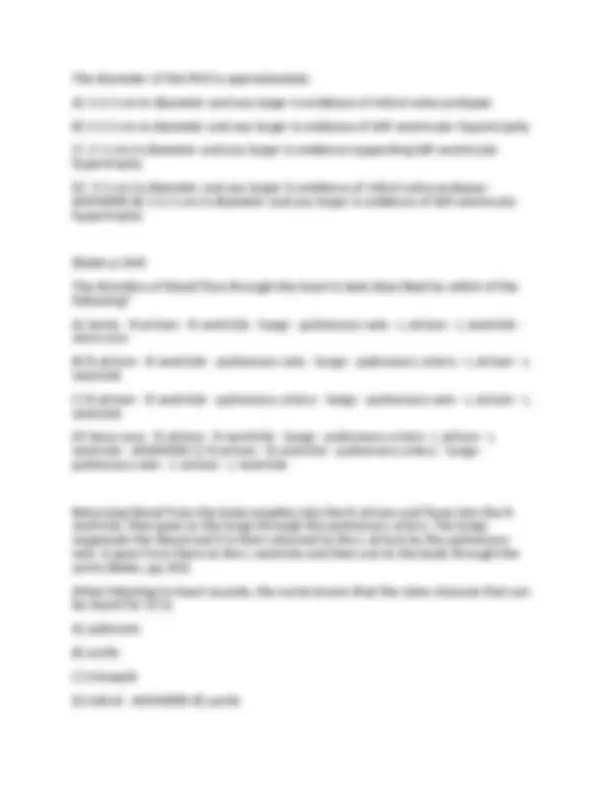
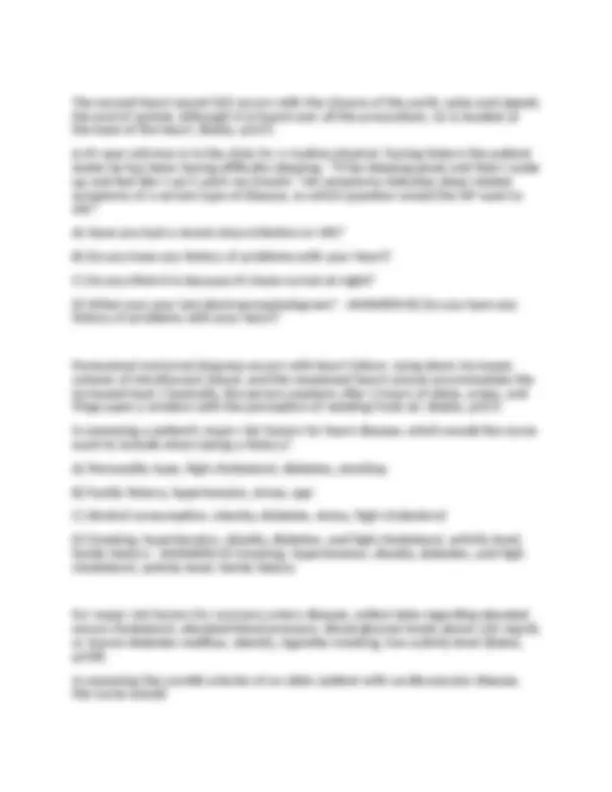
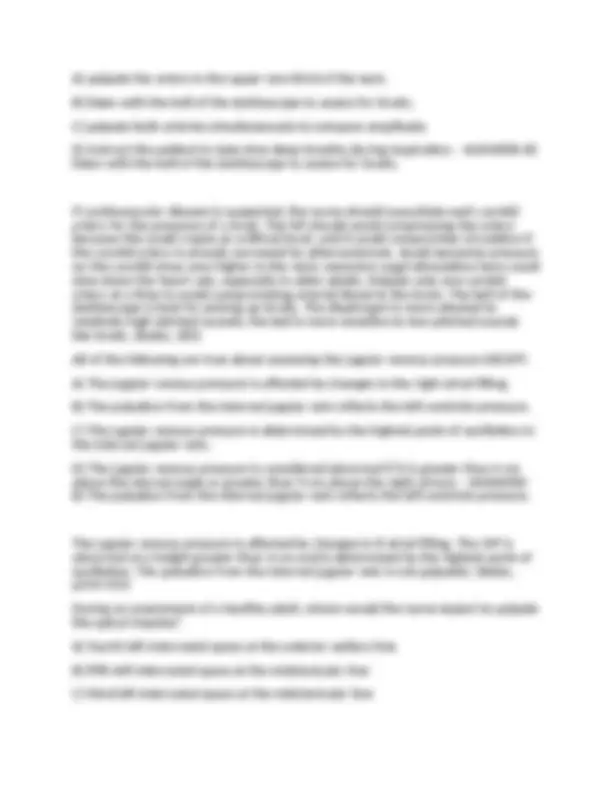

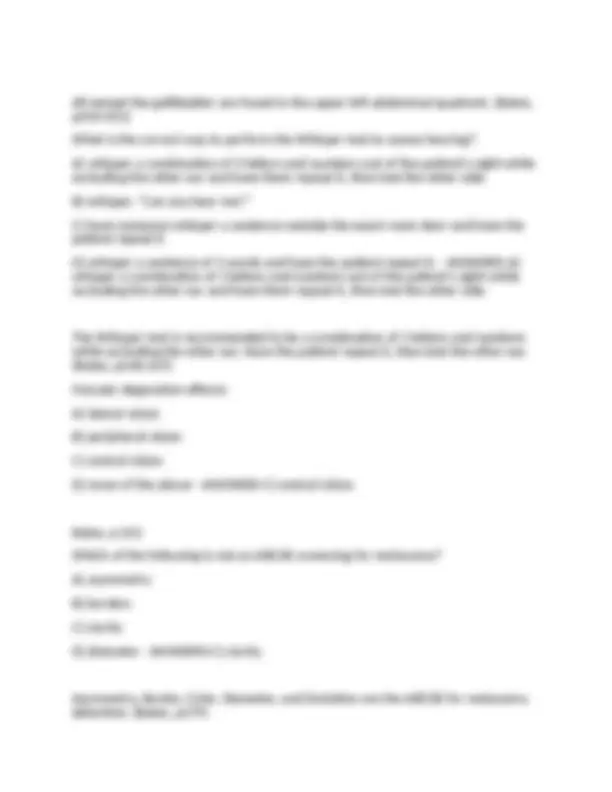
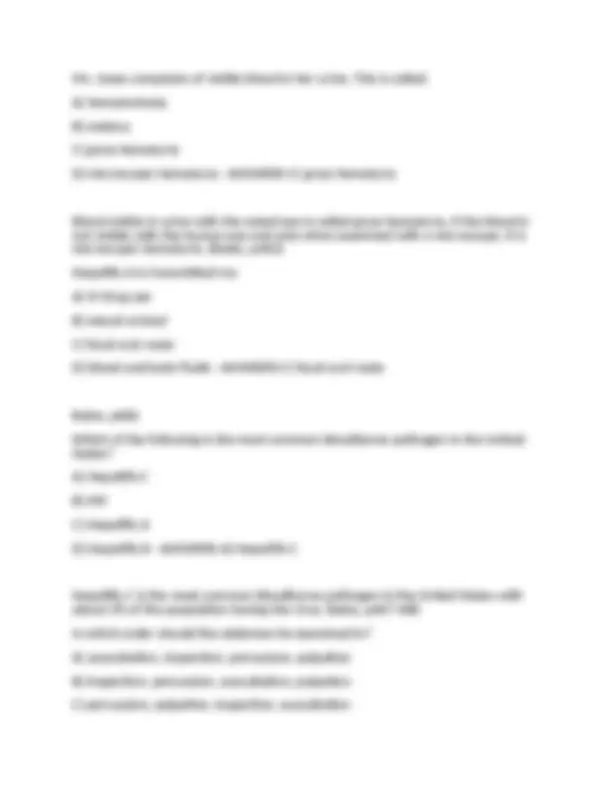
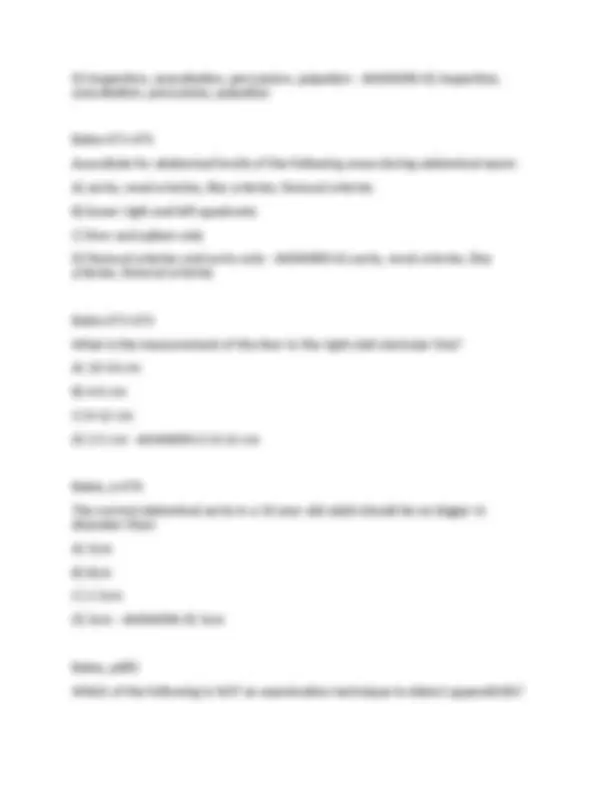

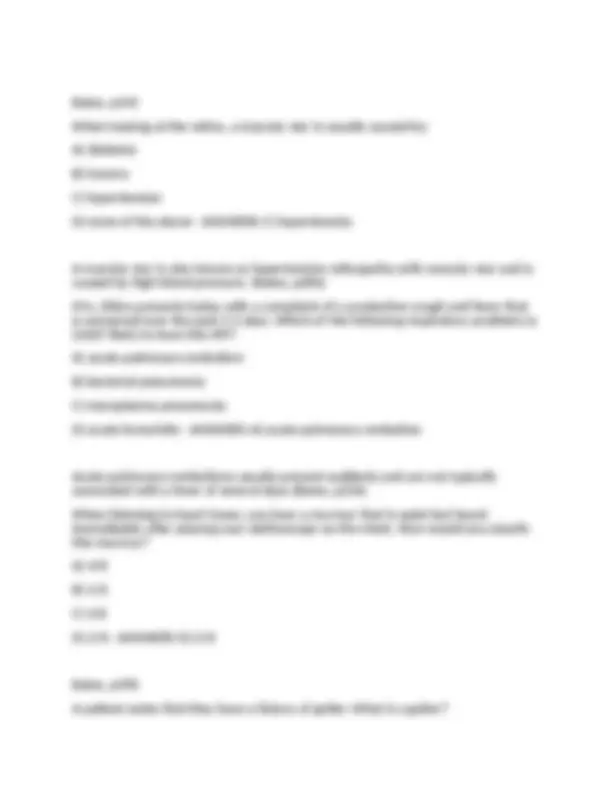
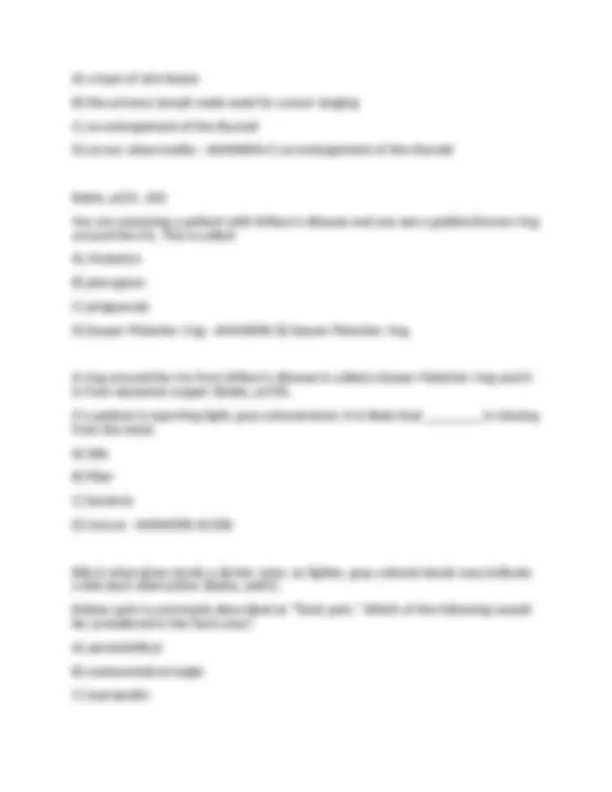
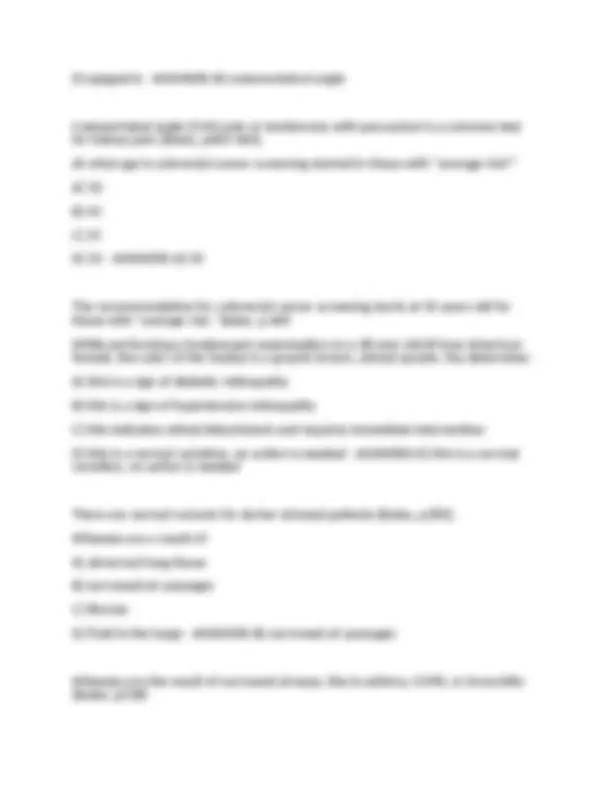
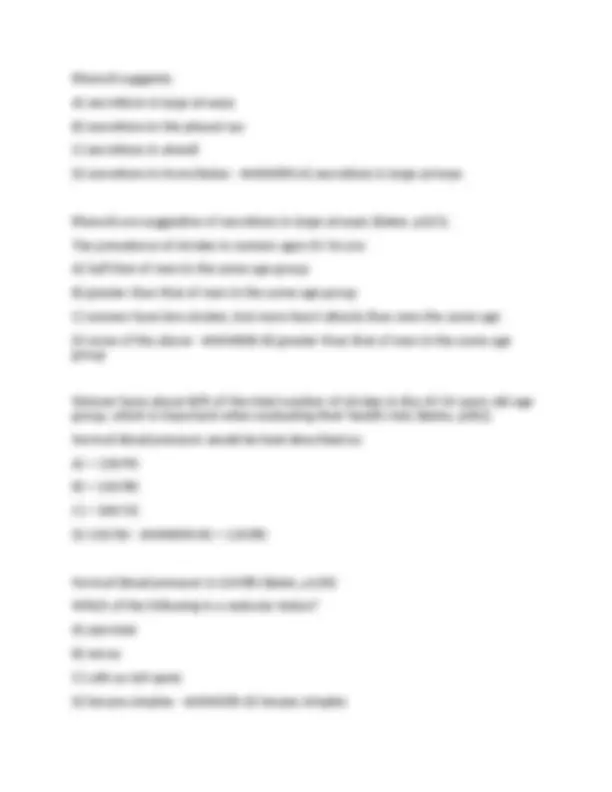
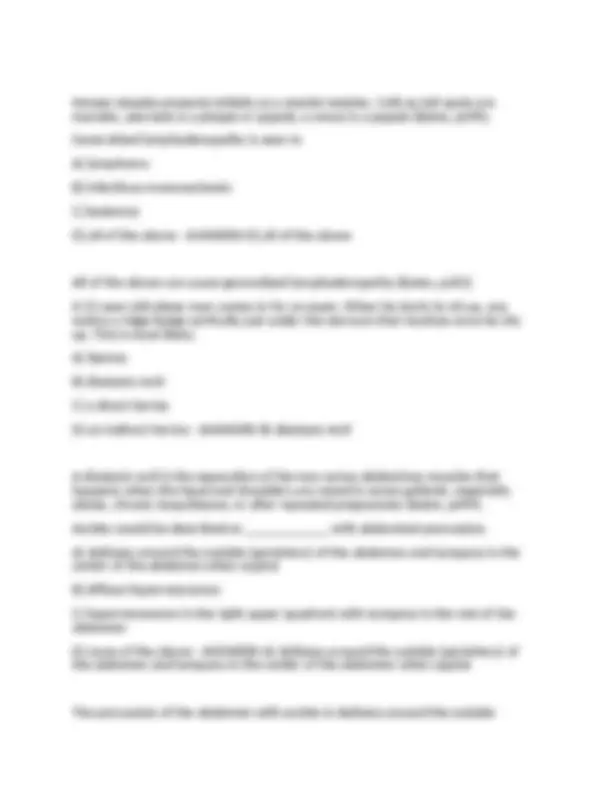
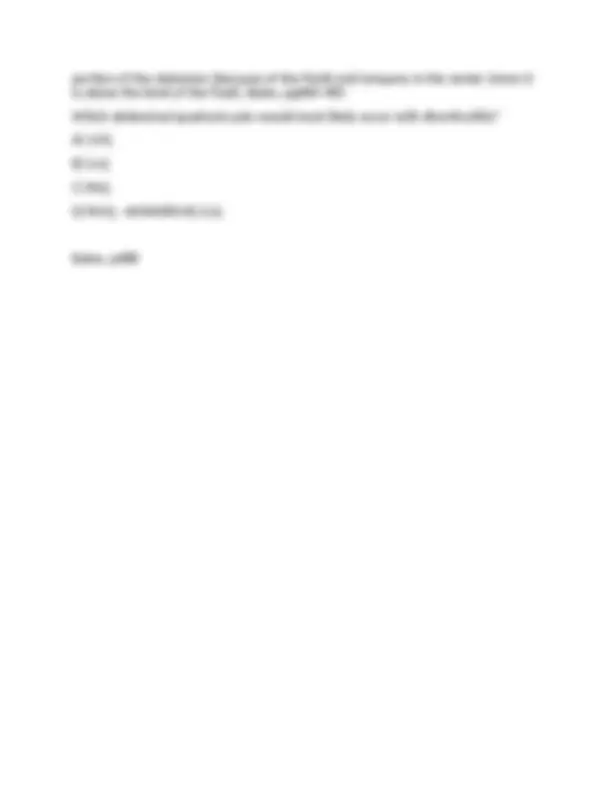


Study with the several resources on Docsity

Earn points by helping other students or get them with a premium plan


Prepare for your exams
Study with the several resources on Docsity

Earn points to download
Earn points by helping other students or get them with a premium plan
Community
Ask the community for help and clear up your study doubts
Discover the best universities in your country according to Docsity users
Free resources
Download our free guides on studying techniques, anxiety management strategies, and thesis advice from Docsity tutors
NUR 5354 Exam 2 Questions With Complete Answers 2025 Latest Update Graded A+ Pass. NUR 5354 Exam 2 Questions With Complete Answers 2025 Latest Update Graded A+ Pass.
Typology: Exams
1 / 35

This page cannot be seen from the preview
Don't miss anything!




























A 59 year old patients tells the nurse practitioner that he thinks he must have ulcerative colitis. He has been having "black stools" for the last 24 hours. How would the nurse practitioner best document THE FACTS for his reason for seeking care? A) JM is a 59 year old male here for having "black stools" for the past 24 hours. B) JM came into the clinic complaining of black stools for the past 24 hours. C) JM is a 59 year old male here for "ulcerative colitis." D) JM, a 59 year old male, states he has ulcerative colitis and wants it checked. - ANSWERS-A) JM is a 59 year old male here for having "black stools" for the past 24 hours. Chief Complaint(s) The one or more symptoms or concerns causing the patient to seek care. Make every effort to quote the patient's own words. A patient tells the nurse practitioner that she has had abdominal pain for the past week. What would be the best response by the nurse practitioner? A) We'll talk more about that later in the interview." B) "Have you ever had any children?" C) "What have you had to eat in the last 4 hours?" D) "Can you point to where it hurts?" - ANSWERS-D) "Can you point to where it hurts?" Each principle symptom should be well-characterized, with descriptions of location; along with the other seven attributes. Location: Ask the patient to point to the pain because lay terms may not be specific enough to localize the site of origin. A 29-year-old woman tells the nurse that she has "excruciating pain" in her back. Which of the following would be an appropriate response by the nurse to her statement? A) "How does your family react to your pain?" B) "That must be terrible. You probably pinched a nerve." C) "I've had back pain myself and it can be excruciating."
D) "How would you say the pain affects your ability to do your daily activities?" - ANSWERS-D) "How would you say the pain affects your ability to do your daily activities?" Inquire about the effects of pain on the patient's daily activities, mood, sleep, work, and sexual activity. In recording the childhood illnesses of a patient who denies having had any, which of the following notes by the nurse would be most accurate? A) Patient denies usual childhood illnesses. B) Patient states he was a "very healthy" child. C) Patient states sister had measles, but he didn't. D) Patient denies measles, mumps, rubella, chickenpox, pertussis, rheumatic fever, and polio. - ANSWERS-D) Patient denies measles, mumps, rubella, chickenpox, pertussis, rheumatic fever, and polio. Childhood illnesses include measles, rubella, mumps, whooping cough, rheumatic fever, scarlet fever, and polio. They are included in the past history. A patient tells the nurse that he is allergic to penicillin. What would be the nurse's best response to this information? A) "Are you allergic to any other drugs?" B) "How often have you received penicillin?" C) "I'll write your allergy on your chart so you won't receive any." D) "Please describe what happens to you when you take penicillin." - ANSWERS-D) "Please describe what happens to you when you take penicillin." Allergies, including specific reactions to each medication, such as rash or nausea, must be recorded. The nurse is taking a family history. Important diseases or problems to ask the patient about include: A) emphysema. B) head trauma. C) mental illness.
C) Obstetrics/gynecology D) Psychiatric - ANSWERS-B) Surgical Provide information relative to Adult Illnesses in each of four areas: Medical, Surgical, Obstetric/Gynecologic, and Psychiatric. During the aging process, the hair can look gray or white and begin to feel thin and fine. The nurse practitioner knows that this occurs because of a decrease in: A) pigmentation B) thyroid stimulating hormone C) phagocytes D) fungacytes - ANSWERS-A) pigmentation Hair undergoes a series of changes. Scalp hair loses its pigment (functioning of melanocytes) so the hair looks gray or white and feels thin and fine. The other options are not correct. You are speaking to an 8th grade class about health prevention and are preparing to discuss the ABCDEs of melanoma. Which of the following descriptions correctly defines the ABCDEs? A) A = actinic; B = basal cell; C = color changes, especially blue; D = diameter > mm; E = evolution B) A = asymmetry; B = irregular borders; C = color changes, especially blue; D = diameter >6 mm; E = evolution C) A = actinic; B = irregular borders; C = keratoses; D = dystrophic nails; E = evolution D) A = asymmetry; B = regular borders; C = color changes, especially orange; D = diameter >6 mm; E = evolution - ANSWERS-B) A = asymmetry; B = irregular borders; C = color changes, especially blue; D = diameter >6 mm; E = evolution You are examining the skin on a 22 year old female when you notice a circumscribed superficial lesion that is elevated approximately 0.5cm in diameter, filled with serous fluid. What type of lesion is this? A) macule B) papule C) vesicle
D) spider angioma - ANSWERS-C) vesicle Vesicle - up to 1.0 cm filled with serous fluid A 72-year-old teacher comes to a skilled nursing facility for rehabilitation after being in the hospital for 6 weeks. She was treated for sepsis and respiratory failure and had to be on a ventilator for 3 weeks. The nurse is completing an initial assessment and evaluating the client's skin condition. On her sacrum there is full- thickness skin loss that is 5 cm in diameter with damage to the subcutaneous tissue. The underlying muscle is not affected. What is the stage of this pressure ulcer? A) Stage 1 B) Stage 2 C) Stage 3 D) Stage 4 - ANSWERS-C) Stage 3 A crater appears in the skin, with full-thickness skin loss and damage to or necrosis of subcutaneous tissue that may extend to, but not through underlying muscle. Mrs. Anderson presents with an itchy rash which is raised and appears and disappears in various locations. Each lesion lasts for many minutes. What most likely accounts for this rash? A) Insect bites B) Wheals, urticaria, or hives C) Psoriasis D) Purpura - ANSWERS-B) Wheals, urticaria, or hives Wheals/urticaria - a somewhat irregular, relatively transient, superficial area of localized skin edema. Ethel is a 68 year old Caucasian female who is new to your area. She shows you multiple brown colored, flat lesions on her face, chest, and hands that have been present for years. You respond that these are likely: A) solar lentigos B) melanomas
rapport. C) Greet the patient, establish rapport, invite the patient's story, establish the agenda, expand and clarify the patient's story, and negotiate a plan. D) Negotiate a plan, establish an agenda, invite the patient's story, and establish rapport. - ANSWERS-C) Greet the patient, establish rapport, invite the patient's story, establish the agenda, expand and clarify the patient's story, and negotiate a plan. The sequence of the interview: Greeting the patient and establishing rapport. Taking notes. Establishing the agenda for the interview. Inviting the patient's story. Expanding and clarifying the patient's story. Sharing the treatment plan. A young woman undergoes cranial nerve testing. On touching the soft palate, her uvula deviates to the left. Which of the following is likely? A) CN IX lesion on the left B) CN X lesion on the left C) CN IX lesion on the right D) CN X lesion on the right - ANSWERS-D) CN X lesion on the right In cranial nerve X paralysis, the soft palate fails to rise and the uvula deviates to the opposite side. When performing posterior palpation of the thyroid gland, you should do all fo the following, EXCEPT: A) Have the patient tip his or her head forward and slightly to the side. B) Place your index fingers above the cricoid cartilage. C) Palpate between the sternocleidomastoid muscle and the trachea for the lobes of the thyroid. D) Move your fingers laterally to palpate for the thyroid lobes. - ANSWERS-B) Place your index fingers above the cricoid cartilage. Place the fingers of both hands on the patient's neck so that your index fingers are just BELOW the cricoid cartilage. You are interviewing an elderly woman in the ambulatory setting and trying to get more information about her urinary symptoms. Which of the following techniques
is NOT a component of guided questioning? A) Reassuring the patient that the urinary symptoms are benign and that she doesn't need to worry about it being a sign of cancer. B) Offering the patient multiple choices in order to clarify the character of the urinary symptoms she is experiencing. C) Asking her to tell you what she means when she states that she has a urinary tract infection. D) Directed questioning starting with the general and proceeding to the specific in a manner that does not make the patient give a yes/no answer. - ANSWERS-A) Reassuring the patient that the urinary symptoms are benign and that she doesn't need to worry about it being a sign of cancer. Bates p 59, 69- Mrs. T. comes for her regular visit to the clinic. She is on your schedule because her regular provider is on vacation and she wanted to be seen. You have heard about her many times from your colleague and are aware that she is a very talkative person. Which of the following is a helpful technique to improve the quality of the interview for both the provider and the patient? A) Allow the patient to speak uninterrupted for the duration of the appointment. B) Briefly summarize what you heard from the patient in the first 5 minutes and then try to have her focus on one aspect of what she told you. C) Set the time limit at the beginning of the interview and stick with it, no matter what occurs in the course of the interview. D) Allow your impatience to show so that the patient picks up on your nonverbal cue that the appointment needs to end. - ANSWERS-B) Briefly summarize what you heard from the patient in the first 5 minutes and then try to have her focus on one aspect of what she told you. Give the patient free rein for the first 5-10 minutes, listening closely to the conversation. Focus on what seems most important to the patient. Learn to set limits when needed. A brief summary may help you change the subject yet validate any concerns. Do no show your impatience. Which of the following will help to optimize success from a pediatric examination? A) Doing the examination out of order if necessary to take advantage of quiet periods for auscultation, etc.
A 29-year-old physical therapist presents for evaluation of an eyelid problem. On observation, the right eyeball appears to be protruding forward. Based on this description, what is the most likely diagnosis? A) Epicanthus B) Ptosis C) Exophthalmos D) Ectropion - ANSWERS-C) Exophthalmos Eye protrusion (proptosis or exophthalmos) The nurse practitioner is performing an eye examination using the ophthalmoscope. Which component is NOT part of the ophthalmoscope? A) lens disc B) aperature C) indicator of diopters D) speculum - ANSWERS-D) speculum See picture of ophthalmoscope (Bates p 238) A 15-year-old high school sophomore presents to the emergency room with his mother for evaluation of an area of blood in the left eye. He denies trauma or injury but has been coughing forcefully with a recent cold. He denies visual disturbances, eye pain, or discharge from the eye. On physical examination, the pupils are equal, round, and reactive to light, with a visual acuity of 20/20 in each eye and 20/20 bilaterally. There is a homogeneous, sharply demarcated area at the lateral aspect of the base of the left eye. The cornea is clear. Based on this description, what is the most likely diagnosis? A) Conjunctivitis B) Acute iritis C) Corneal abrasion D) Subconjunctival hemorrhage - ANSWERS-D) Subconjunctival hemorrhage Leakage of blood outside of the vessels, producing a homogenous, sharply demarcated, red area. The pupil is not affected, vision is not affected and the
cornea is clear. May result from trauma, bleeding disorders, or sudden increase in venous pressure, as from a cough. The nurse practitioner is reviewing for a class in age-related changes in the eye. Which of these physiological changes is responsible for presbyopia? A) degeneration of the cornea B) decreased adaptation to darkness C) decreased distance vision abilities D) loss of lens elasticity - ANSWERS-D) loss of lens elasticity The lens gradually loses its elasticity, and the eye grows progressively less able to accommodate and focus on nearby objects. Ensuing presbyopia usually becomes noticeable during the fifth decade. (Bates, p 959, 991) Mr. Q. is a 45-year-old salesman who comes to your office for evaluation of fatigue. He has come to the office many times in the past with a variety of injuries, and you suspect that he has a problem with alcohol. Which one of the following questions will be most helpful in diagnosing this problem? A) You are an alcoholic, aren't you? B) When was your last drink? C) Do you drink 2 to 3 beers every weekend? D) Do you drink alcohol when you are supposed to be working? - ANSWERS-B) When was your last drink? Positive answers to two additional questions are highly suspicious for problem drinking: "Have you every had a drinking problem?" and "When was your last drink?" especially if the night before (Bates, p 96-97) A patient's vision is recorded as 20/30 when the Snellen eye chart is used. The nurse interprets these results to indicate that: A) the patient can read at 20 feet what a person with normal vision can read at 30 feet. B) at 30 feet the patient can read the entire chart. C) the patient can read the chart from 20 feet in the left eye and 30 feet in the right eye, D) the patient can read from 30 feet what a person with normal vision can read
with manipulation; canal - normal diameter without evidence of inflammation; tympanic membrane - bulging, erythematous, and the light reflex is dull. Insufflation is deferred due to pain. What is your diagnosis? A) ruptured tympanic membrane B) cholesteatoma C) otitis media D) otitis externa - ANSWERS-C) otitis media Acute otitis media in a symptomatic child typically has a red, bulging tympanic membrane, with a dull or absent light reflex. The nurse practitioner is assessing a patient who may have hearing loss. Which of these statements is true concerning air conduction? A) Air conduction is the normal pathway for hearing. B) Vibrations of the bones in the skull cause air conduction. C) Amplitude of sound determines the pitch that is heard. D) Loss of air conduction is called a conductive hearing loss. - ANSWERS-A) Air conduction is the normal pathway for hearing. The normal pathway of hearing is air conduction, which starts when sound waves produce vibrations on the tympanic membrane. Conductive hearing loss results from a mechanical dysfunction of the external or middle ear. The other statements are not true concerning air conduction. When examining the ear of a young child, which of the following is the proper technique to use? A) Examine the ear canal and tympanic membrane as the last steps in the exam if the child is sensitive or fearful. B) Pull the auricle downward, outward, and backward for the best view. C) Use the largest speculum possible on the otoscope. D) All of the above. - ANSWERS-D) All of the above. If a child is fearful or sensitive because she can't see the ear exam, you might need to restrain her so wait until the end of the exam. Use the largest speculum for the
best view. For best visualization, pull the auricle downward, outward, and backward (Bates 867-869). The nurse practitioner might see which of the following physical findings in a patient with otitis externa? A) a bulging, red tympanic membrane B) an unusually prominent short process and prominent handle. C) a chalky, white patch with irregular margins on the inferior part of the tympanic membrane. D) Pain with the movement of the auricle and tragus (tug test): a swollen, narrowed, moist, pale and tender ear canal. - ANSWERS-D) Pain with the movement of the auricle and tragus (tug test): a swollen, narrowed, moist, pale and tender ear canal. Frank blood or clear watery drainage (cerebrospinal leak) after trauma suggest a basal skull fracture and warrants immediate referral. Purulent drainage indicates otitis externa or otitis media. (Bates, 245-246) An Annual Low Dose Computed Tomography (LDCT) screening would be recommended for which patient? A) Tammy, age 57, who smokes a half pack of cigarettes a day for the last 20 years. B) Bob, age 72, who quit smoking 10 years ago after a 30-pack year history. C) Angela, age 43, and started smoking when she was 15 years old. D) George, age 80, who lives with his wife and is a smoker. - ANSWERS-B) Bob, age 72, who quit smoking 10 years ago after a 30-pack year history. LDCT screenings are recommended to patients 55-74 years, a 30-pack year smoking history or current smoking or have quit in the last 15 years (Bates, p315- 316). NP is preparing to perform an otoscopic examination of a newborn infant. Which statement is true regarding this examination? A) Immobility of the drum is a normal finding. B) The light reflex is cone shaped in the first few days of life. C) The appearance of the membrane is identical to that of an adult. D) The normal membrane may appear thick and opaque because of the vernix
allergic rhinitis the mucosa is often pale, bluish, or red. A 46 year old female patient is in the clinic with a chief complaint of chest pain. You are wanting to best understand the patient's perception of the chest pain. Which fo the following questions would you ask first? A) How do you rate your pain on a scale of 0-10? B) Is the pain related to exertion? C) Tell me about your chest discomfort. D) Are you taking all of your medications? - ANSWERS-C) Tell me about your chest discomfort. Move from open ended to focused questions to allow for the flow of ideas and thoughts from the patient. The nurse practitioner is doing an assessment on a 21 year old patient and notices that his nasal mucosa appears pale and bluish. What would be the most appropriate question to ask the patient? A) Have you had any symptoms of a cold? B) Don't ask any questions. This is a normal finding. C) Are you aware of having any allergies? D) Have you been having frequent nosebleeds? - ANSWERS-C) Are you aware of having any allergies? With chronic allergy, mucosa looks swollen, boggy, pale, and gray. Colds and nosebleeds do not cause these mucosal changes. A 10-year-old is at the clinic for "a sore throat lasting 6 days." The nurse is aware that which of these findings would be consistent with an acute infection? A) Tonsils 3+/1-4+ with large white spots B) Tonsils 1+/1-4+ with pale coloring C) Tonsils 1+/1-4+ and pink, same color as oral mucosa D) Tonsils 2+/1-4+ and pink with white particles inside deep crypts - ANSWERS-A) Tonsils 3+/1-4+ with large white spots
With an acute infection, tonsils are bright red and swollen and may have exudate or large white spots. Tonsils are enlarged to 2+, 3+, or 4+ with an acute infection. The nurse practitioner is reviewing the immunization history of a new 24 year old female patient. Which is the best to ask the patient to obtain the needed information for your records? A) Do you need vaccines today? B) When was your last flu shot, tetanus shot? C) Have you received these vaccines in your lifetime? When did you receive them? Tetanus, pertussis, diphtheria, polio, measles, mumps, rubella, influenza, varicella, hepatitis B, haemophilus influenzae type B, pneumococcal, HPV? D) Are your immunizations up to date? - ANSWERS-C) Have you received these vaccines in your lifetime? When did you receive them? Tetanus, pertussis, diphtheria, polio, measles, mumps, rubella, influenza, varicella, hepatitis B, haemophilus influenzae type B, pneumococcal, HPV? Find out whether the patient has received required and recommended vaccines. (Bates, 10) The assessment of a COPD patient will most likely reveal: A) resonant percussion sounds, no adventitious sounds and vesicular breath sounds B) dull percussion sounds and absent breath sounds. No crackles or wheezes C) resonant to hyper-resonant sounds with percussion and wheezes present D) diffusely hyper-resonant sounds with percussion, decreased or absent breath sounds per auscultation, decreased tactile fremitus, and no crackles, wheezes, or rhonchi. - ANSWERS-D) diffusely hyper-resonant sounds with percussion, decreased or absent breath sounds per auscultation, decreased tactile fremitus, and no crackles, wheezes, or rhonchi. COPD is characterized by diffusely hyper-resonant sounds with percussion, decreased or absent breath sounds per auscultation, decreased tactile fremitus, and no crackles, wheezes, or rhonchi. (Bates, p340) Which of the following is true about auscultating the heart? A) the diaphragm is better for picking up the sounds of S1 and S2 and the bell is better for picking up the sounds of S3 and S4.
C) consists of 2 lobes. D) consists primarily of an upper lobe on the posterior chest. - ANSWERS-C) consists of 2 lobes. The left lung has 2 lobes, and the right lung has 3 lobes. The right lung is shorter than the left lung because of the underlying LIVER. The left lung is narrower than the right lung because the heart bulges to the left. The posterior chest is almost all lower lobe (Bates, p307). The primary muscles of respiration include the : A) trapezius and rectus abdominis. B) sternomastoids and scaleni. C) diaphragm and intercostals. D) external obliques and pectoralis major. - ANSWERS-C) diaphragm and intercostals. The major muscle of respiration is the diaphragm. The intercostal muscles life the sternum and elevate the ribs during inspiration, increasing the anteroposterior diameter. Expiration is primarily passive. Forced inspiration involves the use of other muscles, such as the accessory neck muscles (sternomastoids, scalene, trapazii). Forced expiration involves the abdominal muscles (Bates, p309). When auscultating the lungs of an adult patient, the nurse practitioner notes that over the posterior lower lobes low-pitched, soft breath sounds are heard, with inspiration being longer than expiration. The nurse interprets that these are: A) bronchial breath sounds and are normal in that location B) sounds normally auscultated over the trachea C) vesicular breath sounds and are normal in that location D) bronchovesicular breath sounds and are normal in that location - ANSWERS-C) vesicular breath sounds and are normal in that location Vesicular breath sounds are low-pitched, soft sounds with inspiration being longer than expiration. These breath sounds are expected over peripheral lung fields where air flows through smaller bronchioles and alveoli (Bates, p324) The nurse practitioner is auscultating the chest in an adult. Which technique is
correct? A) Instruct the patient to breathe in and out only through his or her nose. B) Use the diaphragm of the stethoscope held firmly against the chest. C) Instruct the patient to take deep, rapid breaths. D) Use the bell of the stethoscope held lightly against the chest to avoid friction. - ANSWERS-B) Use the diaphragm of the stethoscope held firmly against the chest. The diaphragm of the stethoscope held firmly against the chest is the correct way to auscultate breath sounds. The patient should be instructed to breathe through his or her mouth, a little deeper than usual, but not to hyperventilate. (Bates, p323) You can tell that you hear bronchovesicular sounds by the: A) soft, low pitch sound you hear over most of both lung. The inspiratory sounds last longer than the expiratory sounds. B) very loud and relatively high pitch of the sounds heard over the trachea in the neck C) inspiratory and expiratory sounds are equal in duration and pitch is intermediate. Sounds are heard in the 1st and 2nd interspaces anteriorly and between the scapulae D) crepitus palpated at the costochrondral junctions - ANSWERS-C) inspiratory and expiratory sounds are equal in duration and pitch is intermediate. Sounds are heard in the 1st and 2nd interspaces anteriorly and between the scapulae Bronchovesicular breath sounds are heard in the 1st and 2nd interspaces anteriorly and between the scapulae. They are intermediate in intensity. Inspiration to expiration periods are equal. Inspiration and expiration are equal. (Bates, p324) The NP knows that normal newborn lung sounds: A) are harsh and loud in the upper airway of the infant because the stethoscope is closer to the origin of the sounds B) are vesicular C) are easily auscultated without the stethoscope D) are quiet in the infant compared to the adult - ANSWERS-A) are harsh and loud